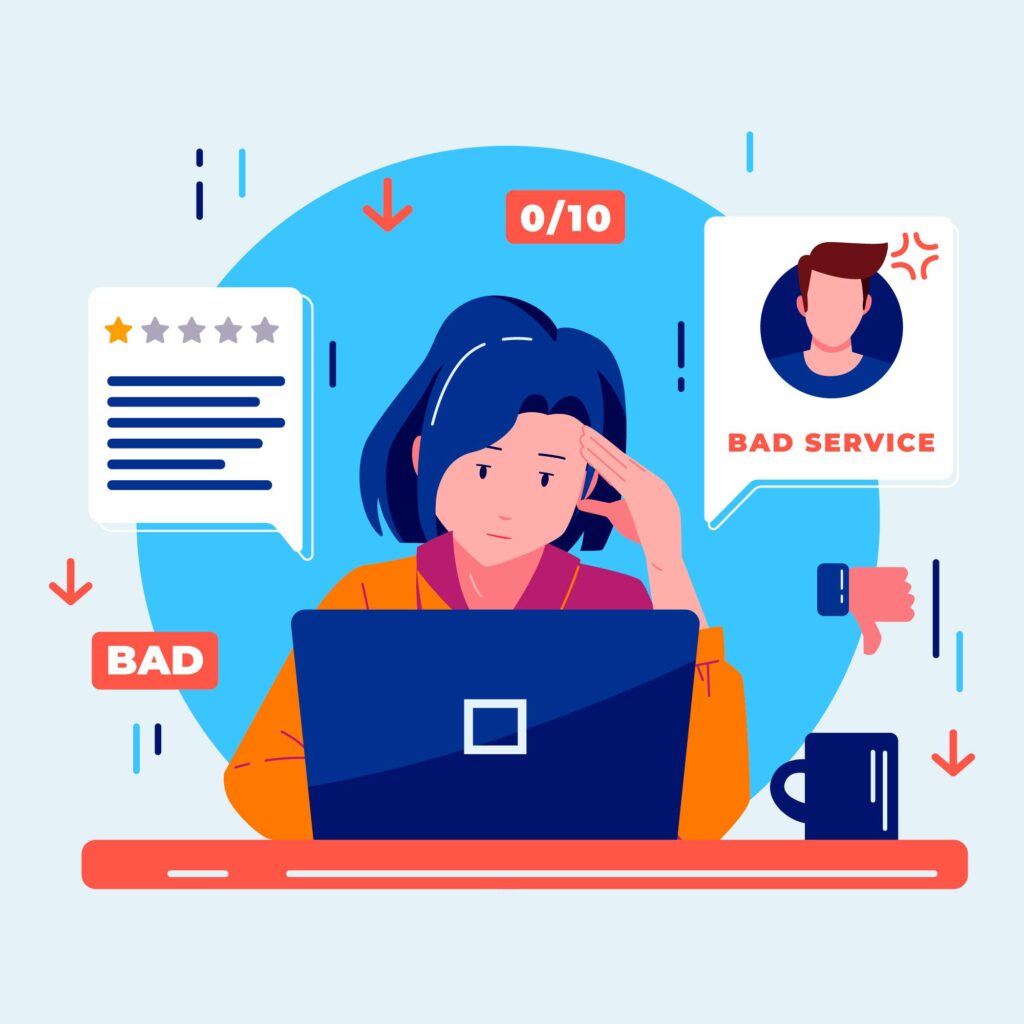Content reigns supreme in the digital world. It’s the lifeblood of your website, attracting visitors, engaging readers, and ultimately driving conversions. But crafting compelling content isn’t always easy. Even seasoned writers can fall into common traps that sabotage their efforts.
This guide delves into the top 5 content writing mistakes that can sink your website and provides actionable strategies to steer clear of them. Whether you’re a seasoned content creator or just starting out, this roadmap will equip you with the knowledge to produce high-quality content that resonates with your audience and fuels your online success.
Content Writing Mistakes #1: Lack of Audience Understanding
The Problem:
Writing in a vacuum is a recipe for disaster. Without a clear understanding of your target audience, your content becomes generic and fails to connect. It won’t address their specific needs, pains, or interests.
The Solution:
1. Define Your Ideal Reader:
Create a buyer persona – a detailed profile of your ideal customer. Consider demographics like age, location, and occupation. More importantly, delve into their psychographics: interests, challenges, and online behavior. Research industry reports, social media trends, and conduct surveys to gather data.
2. Tailor Your Content:
Once you understand your audience, tailor your content to their needs. Use language they understand, address their specific pain points, and offer solutions that resonate with their interests.
3. Speak Their Language:
Avoid industry jargon and technical terms unless absolutely necessary. Use clear, concise language that’s easy to understand. Integrate relevant keywords naturally throughout your content to improve search engine ranking.
Example:
Before (Lack of Audience Understanding):
This blog post explores the intricacies of content marketing strategies for B2B businesses.
After (Tailored to Audience):
Are you a small business owner struggling to attract new customers online? This guide outlines simple but effective content marketing strategies that can help you generate leads and grow your business.
Content Writing Mistakes #2: Ignoring Search Engine Optimization (SEO)
The Problem:
Even the most engaging content won’t reach your target audience if it’s buried deep within search engine results. Ignoring SEO principles limits your online visibility and significantly reduces traffic to your website.
The Solution:
1. Keyword Research:
Identify the keywords your target audience uses to search for information online. Utilize keyword research tools like Google Keyword Planner or SEMrush to discover relevant search terms with high volume and low competition.
2. Strategic Keyword Integration:
Integrate your target keywords naturally throughout your content, including the title, headings, subheadings, and meta description. However, avoid keyword stuffing as it can negatively impact user experience and search engine rankings.
3. Optimize for User Intent:
Focus on creating content that aligns with user intent – the underlying reason behind a search query. Are users seeking information, looking to compare products, or ready to make a purchase? Tailor your content format and answer their questions comprehensively.
Example:
Before (Ignoring SEO):
The Benefits of Using Recycled Rubber Flooring
After (Optimized for Keyword and User Intent):
Is Eco-Friendly Flooring Right for Your Home Gym? Exploring the Benefits of Recycled Rubber Flooring

Content Writing Mistakes #3: Failing to Structure Your Content
The Problem:
A disorganized wall of text overwhelms readers and makes it difficult to retain information. Without a clear structure, your content loses its flow and fails to guide readers on a well-defined journey.
The Solution:
1. Craft a Compelling Headline:
Your headline is the first impression – make it count. Use strong verbs, clear language, and intrigue to grab attention and encourage clicks.
2. Utilize Headings and Subheadings:
Break up your content with clear headings and subheadings that reflect the main points and sub-topics of your writing. This improves readability and allows readers to scan and find specific information easily.
3. Leverage Bullet Points and Lists:
Bullet points and numbered lists enhance readability and make complex information easier to digest. They visually break up text-heavy sections and highlight key takeaways.
4. Conclude with a Call to Action (CTA):
Tell your readers what you want them to do next. Whether it’s subscribing to your newsletter, downloading a whitepaper, or contacting you.
Also Read- A New Dawn for AI – Enter Google Gemini
Content Writing Mistakes #4: Sacrificing Quality for Quantity
The Problem:
The pressure to churn out content consistently can lead to a focus on quantity over quality. Thin, hastily written content lacks depth, fails to engage readers, and ultimately hurts your website’s reputation.
The Solution:
1. Prioritize Quality:
Focus on creating well-researched, insightful, and informative content that provides value to your audience. Invest time in proper grammar, clarity, and compelling writing.
2. Conduct Thorough Research:
Back up your claims with credible sources – industry reports, academic studies, and expert opinions. This strengthens your content’s authority and establishes you as a thought leader in your field.
3. Edit and Proofread Rigorously:
Typos, grammatical errors, and factual inaccuracies erode trust. Proofread your content meticulously and consider using editing tools or services to ensure professional quality.
4. Focus on Value Over Fluff:
Avoid generic content that offers no unique insights. Focus on providing valuable information that your audience can’t find elsewhere.
Example:
Before (Prioritizing Quantity):
5 Reasons Why Content Marketing is Important (written in 30 minutes)
After (Prioritizing Quality):
The Ultimate Guide to Content Marketing for Small Businesses: Attract Leads, Drive Sales, and Build Your Brand (well-researched, in-depth content).
Content Writing Mistakes #5: Failing to Promote Your Content
The Solution:
1. Leverage Social Media Platforms:
Share your content across relevant social media platforms. Utilize engaging visuals, compelling captions, and relevant hashtags to attract attention and drive traffic to your website.
2. Email Marketing:
Promote your content to your email subscribers. Craft engaging email subject lines and provide a compelling summary of your content to entice readers to click through.
3. Guest Blogging:
Reach a wider audience by guest blogging on websites within your niche. Contribute high-quality content that showcases your expertise and includes a link back to your website.
4. Influencer Marketing:
Partner with relevant influencers in your industry. Offer them early access to your content and encourage them to share it with their audience.
5. Paid Advertising:
Consider utilizing paid advertising platforms like Google Ads or social media advertising to promote your content to a targeted audience. This can be a powerful way to reach a wider audience quickly.
6. Content Syndication:
Syndicate your content on relevant websites and online publications. This can increase exposure and drive traffic back to your website.
7. Track and Analyze:
Monitor the performance of your content using analytics tools. Analyze metrics like traffic, engagement, and conversions to identify what’s working and what needs improvement.
Example:
Before (Neglecting Promotion):
We published a great blog post on sustainable building practices, but it received minimal traffic.
After (Active Promotion):
We shared our blog post on social media, included it in our email newsletter, and reached out to relevant green building websites for syndication. As a result, we saw a significant increase in website traffic and engagement.
Conclusion: Avoiding the Pitfalls and Writing Winning Content
By recognizing and avoiding these common content writing mistakes, you equip yourself to create high-quality content that engages your audience, drives traffic, and ultimately fuels your online success. Remember, content writing is an ongoing process. Experiment, learn from your mistakes, and strive to continuously improve your content creation skills. By prioritizing audience needs, incorporating sound SEO practices, and actively promoting your work, you can transform your content into a powerful tool for achieving your online goals.


